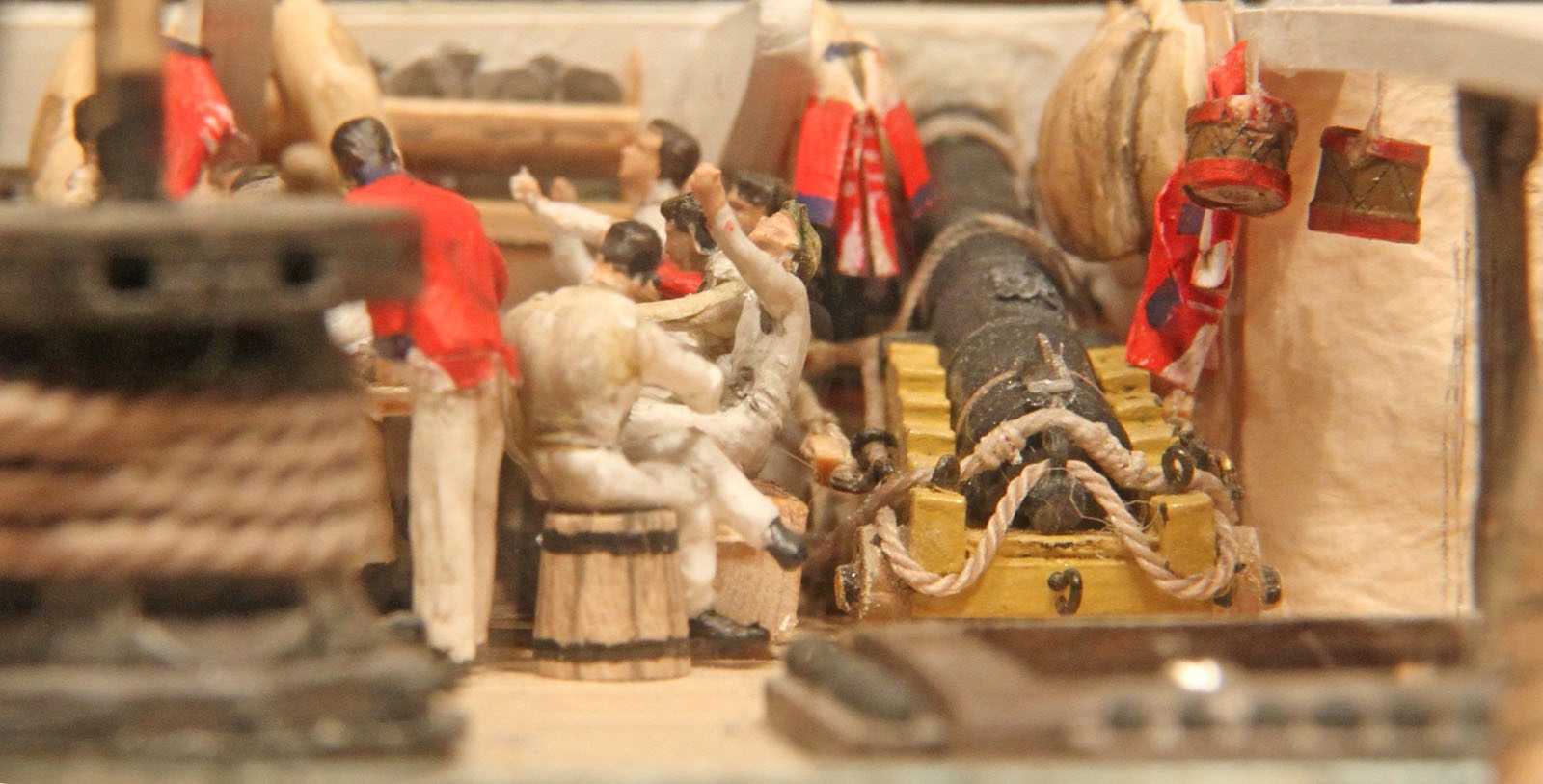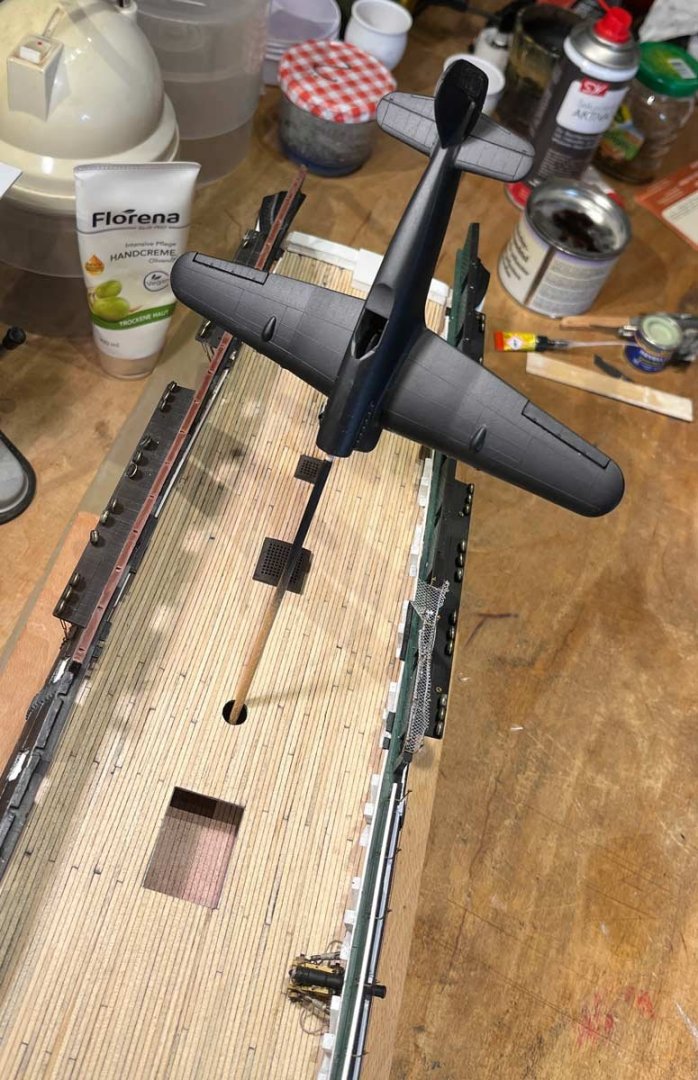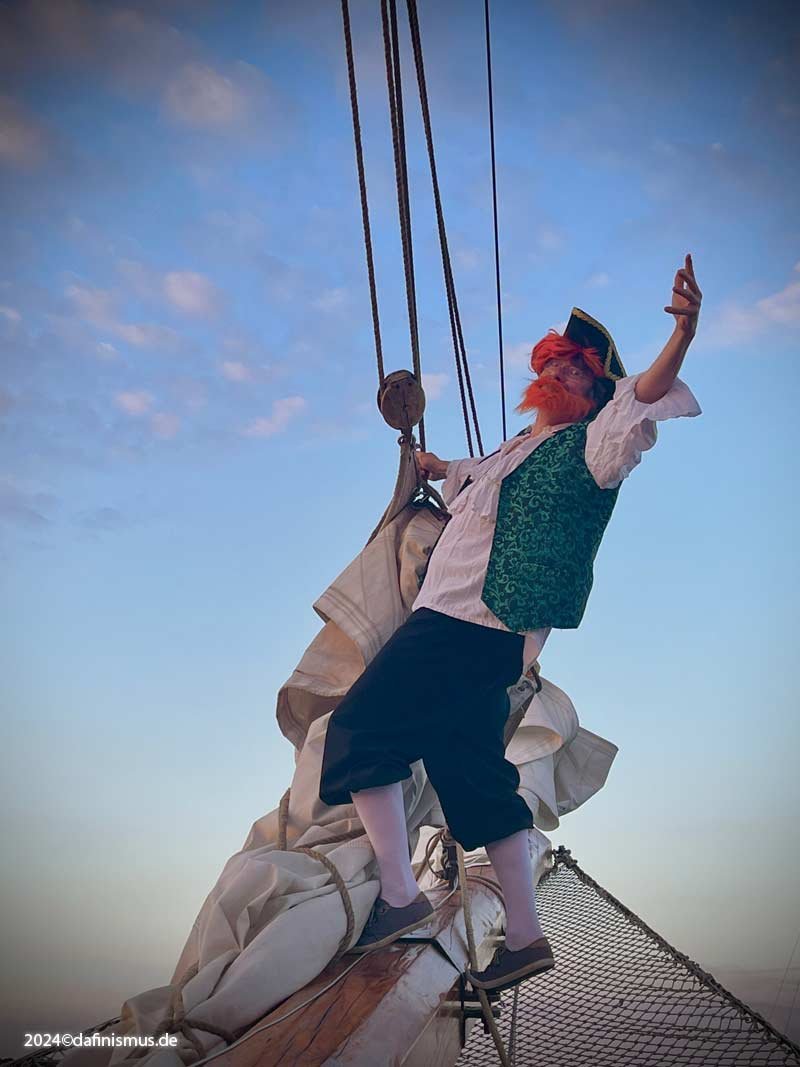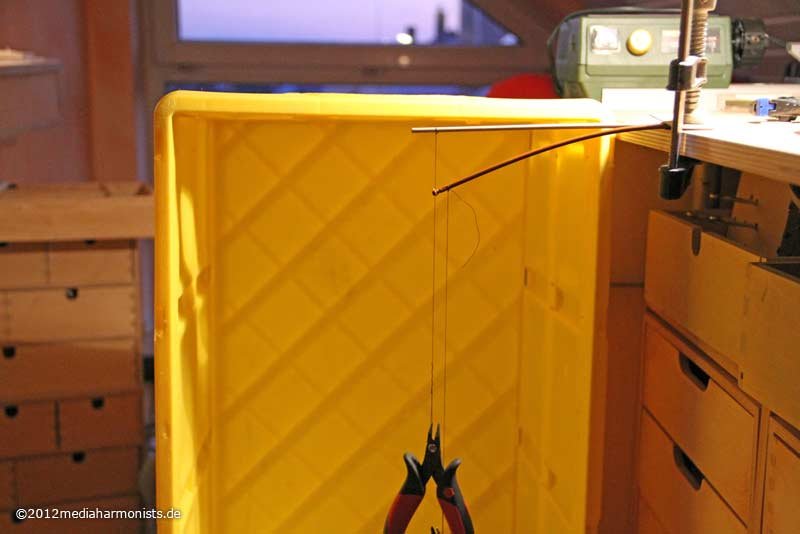-
Posts
2,411 -
Joined
-
Last visited
Content Type
Profiles
Forums
Gallery
Events
Everything posted by dafi
-
Something strange happened on the way to the shipyard ... ... no, it´s neither England 1940 HMS Wellesley against Luftwaffe nor Okinawa 1945 USS Bunker Hill and japanese kamikaze ... ... XXXDAn https://www.google.de/search?q=hms+wellesley&biw=2319&bih=1379&tbo=u&source=univ&sa=X&sqi=2&ved=0ahUKEwiPhd6J09PJAhXKXRQKHcDMBdAQsAQINg&udm=2 [URL=https://en.wikipedia.org/wiki/HMS_Wellesley_(1815)]HMS Wellesley Wikipedia uk[/URL]
- 58 replies
-
- Revell
- Constitution
-
(and 1 more)
Tagged with:
-
Anyway you need different sizes for the different yards 🙂 I took 1.8 mm diameter for the top yards and 1.4 mm for the topgallant, a good balance in between appearence and handling. Do not forget the ribs in between 🙂 For the gaff and boom I use 1,5 diameter with the same length but no rips. And here some parrels in their natural habitat on the topgalland yard of Hendrika Barthelds. Much smaller as the sail is smaller too, no ribs and one can see, some loosness and space on the rope, as some of the balls have exploded in a recend storm. The able seaman (not me landlubber) was replacing them shortely after this picture was taken 🙂 XXXDAn
-
If the knots are getting too big, that it a good sign that the yarn for the ratline is oversized! Circumference 1,5 Inch on the lower masts on big ships, otherwise just 1 inch. Just calculate the diameter for your scale 🙂 And with some training, the clove hitch goes as fast as an overhand knot but looks far better in an even appearence. XXXDAn
-
I think the warm water is a better option than the hair dryer, as it is better controlable. As most paints are not touchy against water, it should not matter. If it is, just wash off all paint in the process 🙂 Still replacing is one of the best options 😉 XXXDAn
-
Have alook at paintings of the said period and nation. Best clue you can get. XXXDAn
-
It was marvellous, especially as, unlike modern yachts, the old lady really is sailed as it was done some 400 years ago, so we had 1 skipper, 2 able seamen and us 25 landlubber who had to lend all hands as instructed. Almost everyone is needed to set the gaff sails. Hoisting in and stowing the headsails is also a marvellous task, especially the outer jib with the largest sail mass of the three sails and the smallest space to work on, as the net actually leaves no room for feet. And the mass of cloth can really put up good fights, especially with some wind incorporated. And knowing that, unlike the sailors on the Victory 250 years ago with their much larger sails to cope with, we were are at least well secured out there ... In the past, it was the sailors who built models, today the modellers come to the ship FCC to understand what they are actually building. And there are few places one can get closer to this than folding an outer jib 🙂 XXXDAn
-
Happiness is a warm gun ... ... nooooo ... Happiness is once again being able to stick your nose in the wind ... ... with space above it ... ...and space below. Just let your gaze wander to the horizon. It's funny how everything suddenly looks so small. And let the little blue spot - aka Sweetheart - drop a little kiss from above. Or wave to the boys in the jib net ... ... or take a leisurely stroll at the front of the jib boom and enjoy the wind, sun and waves at over 8 knots. And look forward to the evening, because the 3 headsails ... ... I was allowed to salvage and stow it every evening while still underway, so that everything looked safe and smart in the harbour. And this is the old Lady, the Hendrika Bartelds ... ... just to be happy XXXDAn
-
But of course I did! There was no other way getting me the rum - they found out I can´t sing AND drink at the same time ... XXXDAn
-
Strengthening the mast, but at all times not only war, means also in bad weather 🙂 XXXDAn
-
The best parties always take place in the kitchen. First of all, of course, we need the kitchen worktop. Coincidentally, one of the prints I had made for the Revell Constitition fits like a glove, no wonder, almost the same scale and the design was based anyway on the design of the British 😉 Anyway, the kitchen and hearth are only worth as much as the life that takes place there. The first three men assigned to kitchen duty were quickly pressed. Frederick Bush, the 24-year-old, hunky German is fetching firewood, Irishman Thomas Foley, at 47 one of the oldest crew members on board, will be working on a meat-like structure and Hans Yaul from Switzerland will be chasing the protein-rich maggots out of the cheese with his big knife. Number 4 was more of a challenge. It's always nice when the kits come with little men, but they're usually not the right kind of hands-on character. Here on the right is a sailor from the Constitution kit. Any sailor would immediately fall over on land with his legs in a row like this, so I first changed the leg position to a stable three-point position and also tilted the head slightly for the dynamics. After all, he should be fuelling the stove. However, the test position then showed a completely incorrect and far too static posture for this. So he bent his back and brought his second arm into a working position. Now he finally looks like somebody doing a job. Number 4 is alive 🙂 I then used one of my misprints to prepare the wood filling. The grill at the front of the Brodie Stove has 3 sections, so apparently you can fire it in 3 sections depending on what capacity you need. This is also the log length that dear Frederick has in his arms at the moment. Afterwards, the lower decks are secured against falling objects with cotton wool pads ... ... and the grill is carfully loaded with firewood. We now know that our dear Lord of the Fire is 28-year-old James Caton from Brazil, with the logs that Frederik has placed in front of him and two bags of coals next to him for a nice, even heat. And here you can already see why I had to shorten the height of the Brodie Stove compared to the original drawings: of course it has to pass under the deck beam and the two lids at the top should still be accessible. That's why there is a gap of exactly one deck beam width between the chimney and the lids at the top. How these two boilers could be effectively operated and cleaned with this limited access is still beyond my understanding. Just like the automatic turning mechanism of the grill spit at the front. I know of English country houses that have a similar system, but there are usually much larger fires at work. The mechanics of the drive chain and the corresponding bearing of the spit are also not yet technically comprehensible to me in detail, even if they are based on identical plans in the NMM. Furthermore, you have to bear in mind that the whole stove in Portsmouth is only a replica based on the plan just mentioned. I think back then, the stove size and installation situation were customised for each ship. Whether this is all correct in the replica is therefore not known. And fortunately, the difference in height is no longer noticeable once installed in the model. And while we're on the subject of size and deck height, Frederick, with his height of 1.9 metres, which was unusual for the time but not uncommon, also has a problem here ... ... that standing is just about possible, but the next deck beam is already lurking for his head. So he was clever enough to adopt a slightly more stooped posture to wriggle himself past the firewood, the coal bags and the water barrels. In the small cooking chamber you can already see that with two people it's going to be a tight squeeze, especially if there's someone else working on the stove. I have deliberately avoided decorating the worktop like the breakfast buffet in Portsmouth, as everyone brings what they need for cooking from their mess and has to leave a clean worktop afterwards. After all, this is the only cooking area for 800+ crew members. And that's the end of the small picture in the picture, just a few more impressions 🙂 Prost Mahlzeit, XXXDAn
-
Thank you druxey! Well, Augsburg is now over and all buyers of my block collection have received a free update that includes the Steel specifications. I hope I haven't forgotten anyone, if not please let me kno 🙂 And after all those blocks, time for a chang 🙂 A long time ago I had already presented the built Brodie stove. Cooking place for 800 men. First mishap - I had actually misplaced it for almost a year ... Second mishap - space test and the stove turned out to be 2 mm too high ... In the meantime, because of the unavailability of the original, I had made it again in print ... ... on the right the recovered stove, in the centre the first print - also too high - and on the left the right-scaled version, here the printing technique actually helped to quickly define the correct size, as I had scaled the stove in 2 % steps and could therefore simply place the results on my deck and select the appropriate size. And the winner is: XXXDAn
-
It was nice again and my little one with the black and yellow stripes really enjoyed the trip 🙂 As every 2 years there was a big meeting in Augsburg, around 70 modellers, some with their partners, met, chatted with each other, had a nice evening together and many even had a great Sunday breakfast together. Here are a few pictures of my little one with her accessories. I was also able to take part in and witness a Guinness of World Record attempt: Matthias registered his ship in a bottle as the largest free-hanging ship in a bottle. Now we're just waiting for the certification 🙂 Well then, a nice greeting from both of us, DAniel and Vicky
-
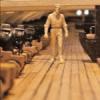
British Pathe film: Model Boat Building, 1956.
dafi replied to uss frolick's topic in Nautical/Naval History
I love the suit although the tye is missing - I think it is time to bring back a bit of style back into our workshops - Just ask Jeeves 😉 With me, the table would be scrap after one tinkering session. But it is amazing with what somnambulistic confidence he prepares the parts, simply stunning! Also the way he takes the measures from the pictures, simply a compass. Of course some might be fake for the TV, but still it is a great testimonial of the ancient kind of modelers. All the best, Daniel ... gone to look for his tye ... -
A small test I did for my Heller Victory ages ago: Same dimensions, same weights. Guess which one is the original plastic kit´s part and which the wooden replacement 😉 XXXDAn
-
The next adventure and small intermezzo were the blocks under the fore fighting top. Here, leech- and buntline run colorfully mixed with the braces of the sprite sail yard and top yard through a wonderful collection of blocks. The first attempt was the classic way of doing the strop first ... ... and then pull it through to the top from below and push the toggle through the upper loop. It worked, but it was a rather messy and uneven act. Then prepared another block, but didn't tie the top loop ... ... and pushed the free end from the bottom to the top, tied a loop there with an auxiliary thread and brought the free end back down. Now I was able to pull the loop at the top tight from below, insert the toggle and adjust the length with the free ends of the binding, knot everything and neaten the whole thing. It looks much better http://www.shipmodels.info/mws_forum/images/smilies/icon_smile.gif You can see the 3 different blocks, with the outer one having two differently sized wheels. This is due to the fact that there are four rope thicknesses in use at this point, resulting in simply beautiful details. And it also looks very tidy from above. And if one wonders about the different layout of the battens, very simple: the Admirality Order from 20. Nov.1802 defines the tops of great ships to be done out of fir instead of oak and to be fitted in two halves http://www.shipmodels.info/mws_forum/images/smilies/icon_smile.gif This made the tops less haevy and far more easy to be exchanged if damaged. Yay! XXXDAn
-
The main yard was finally also finished so far, here is an overview of the collection of all the blocks that have now snuggled together. Always seen from both the front and the aft. And as already written earlier, the stirrups and foot horses will only be smoothed and provided with gravity during the final installation. The center of the yard with the chain sling ... ... and the yard arm, 9 blocks in 8 sizes :-0 Then came the exciting moment, the test hanging http://www.shipmodels.info/mws_forum/images/smilies/icon_smile.gif First the lifts. Then the yard tackles with outer tricing line. And usually as last the braces. And there is another little tidbit that is not normally seen on models. According to Steel, the rope slings were replaced by chain slings in wartime, as can be seen in the pictures of the lifts. Consequently, the forward-facing preventer braces should also be fitted. These replaced the double pendant of the braces of the 1760s. For this purpose, the brace was attached to the rearmost shroud of the foremast, ran to a block on the front of the yard, back to a block on the rearmost shroud and from there to the forecastle. Exciting. XXXDAn
-
Yepp, it is Lees where I found it first, then being confimed by the find at Steel. By this resaerch it became quite obvious that Lees uses quite a lot of Steels informations, sometimes word by word. (This is not a moan 🙂 ). These details can be found in Part III "Progressive Method of Rigging Ships" in the article of "Rigging the the Lower-Yards" in the passage about Fore- and- Main-Braces, Preventer-Braces and Slings. Also most of these details are repeated in the "Tables of the Dimensions of ..." in the sections for lower fore mast and lower main mast. XXXDAn
-
And another little tid bit that is not normally seen on models. According to Steel, the rope slings were replaced by chain slings in wartime. And if "the road to Trafalgar" doesn't count as wartime, what does ?!? Here you can also see that the chain sits on a wedge at the back, whereas the rope slings is passed over the bolster of the mast head. Until 1760, the braces were supported by preventer braces, whereby the hanger was doubled. However, as this proximity was certainly not as effective when under fire, the preventer brace was later brought to the front of the yard. Consequently, since the chains are attached here, the forward-facing preventer braces should also be attached. For this purpose, the standing part of the brace was attached to the rearmost shroud of the foremast, ran to a block on the front of the yard, back to a block on the rearmost shroud and from there to the forecastle. Exciting. XXXDAn
-
And at some point we got serious with the foot horses. First the thimbles were tied into the stirrups and the four-pack on each side was secured against being breathed away. For the research of the length of the stirrups please look here: https://www.mediaharmonists.de/bilder/Sammler39/Victory-Blocks-240415_8487.jpg Then average out the distances for the stirrups. https://www.mediaharmonists.de/bilder/Sammler39/Victory-Blocks-240415_8489.jpg For the distance between the thimble and the upper reference point, I made a small 9 mm gauge so that the distance is even when being glued down. Then 3 turns with the free end and glued that on too. When all 4 stirrups were in place, the foot horse was pulled through the thimbles and secured with an external knot before and after the thimble to prevent it from slipping through. https://www.mediaharmonists.de/bilder/Sammler39/Victory-Blocks-240415_8495.jpg Then a short standing test, and lo and behold, it looks quite plausible. https://www.mediaharmonists.de/bilder/Sammler39/Victory-Blocks-240416_8507.jpg Then knotted the eye on the inside of the foot horse to secure it. It was THE perfect eye. But I had overlooked the fact that the clamp on the other side of the yardarm went further out than expected, see orange thread ... ... so I cut off the eye and spliced in an extension, luckily it's hardly noticeable at this point, uffz. https://www.mediaharmonists.de/bilder/Sammler39/Victory-Blocks-240421_8511.jpg This time the length was better and the eye was lashed with 4 turns on the other side of the yard. https://www.mediaharmonists.de/bilder/Sammler39/Victory-Blocks-240421_8514.jpg Here is the finished ensemble and ... https://www.mediaharmonists.de/bilder/Sammler39/Victory-Blocks-240425_8527.jpg ... even our little able seaman was happy with it up there. https://www.mediaharmonists.de/bilder/Sammler39/Victory-Blocks-240425_8561.jpg XXXDAn
-
I worked hard on that! *ROTFL* If you allow one hint: If possible use a thinner thread for serving shrouds and stays and all on your machine, the one shown appears too thick. Great work as usual! All the best, Daniel
-
Another difference I noticed are the yard tackle blocks and the braces pendants. Steel mentions that the pendants of the braces of the main yard*** were 1/10 of the length of the yard. In the navy they were sometimes operated without pendants, i.e. the block was lashed directly to the yardarm. In this matter, one probably has the freedom, as long as no direct references can be found in the logbooks. Are there any hints for that? @Morgan It is interesting to note that Steel has replaced many long tackle blocks with normal double blocks. In particular, the stay tackle blocks and the yard tackle blocks are equipped with 17" double blocks instead of 24" long tackle blocks. More stable blocks or simplification of the material list? Or signs of the beginning machine milling of blocks? All other sources speak of violin blocks for the entire time frame. Steel also gives the length of the pendants of the yard tackle blocks as 1/10 of the yardarm length. In many other sources I have the impression that the pendants extend to the fishing in the middle of the yard, i.e. they were about twice as long. The two different versions are shown opposite each other in the picture. And how could it be otherwise, questions upon questions ... XXXDAn *** The brace pendants of the foresail are 1/8 of the yard length according to the Steel
-
After the leechline and bowline blocks had worked out so well, we continued with the tricing lines of the yard tackles pendants. The block on the yard tackle pendant was hauled to the yard with the outer tricing line and the lower block with hooks was hauled with the inner tricing lines to the shrouds to be hooked/fastened there. Unlike other load rigs, the yard tackles were not struck off when not in use, but were also used as to support the braces in strong winds or for other purposes. And so that the whole thing doesn't get too boring, this time the blocks are 7" and 8", i.e. 2 mm in my scale. But it doesn't matter, it works just like the other 🙂 First on the filed needle, then stropped in as usual ... ... and succeding the function test. Fits. Then, as usual, tied the eyes with the pointed clamping tweezers and quickly put them all on the leash, such a stopped block is too quickly inhaled. And to show that you can get these blocks to the yard even with sausage fingers like mine ... ... you just have to make sure that you … … get not tangled. And already finished. You can clearly see the noticeable difference between the 2 mm block of the tricing line and the 2.5 mm blocks of the leechline. The tricing line is one of the thinnest in the entire rigging, here hanging loosely with the yard tackle in use ... ... and with the yard tackle pulled up. For the sake of completeness, the inner tricing line next to the 4 mm clue line block. XXXDAn
About us
Modelshipworld - Advancing Ship Modeling through Research
SSL Secured
Your security is important for us so this Website is SSL-Secured
NRG Mailing Address
Nautical Research Guild
237 South Lincoln Street
Westmont IL, 60559-1917
Model Ship World ® and the MSW logo are Registered Trademarks, and belong to the Nautical Research Guild (United States Patent and Trademark Office: No. 6,929,264 & No. 6,929,274, registered Dec. 20, 2022)
Helpful Links
About the NRG
If you enjoy building ship models that are historically accurate as well as beautiful, then The Nautical Research Guild (NRG) is just right for you.
The Guild is a non-profit educational organization whose mission is to “Advance Ship Modeling Through Research”. We provide support to our members in their efforts to raise the quality of their model ships.
The Nautical Research Guild has published our world-renowned quarterly magazine, The Nautical Research Journal, since 1955. The pages of the Journal are full of articles by accomplished ship modelers who show you how they create those exquisite details on their models, and by maritime historians who show you the correct details to build. The Journal is available in both print and digital editions. Go to the NRG web site (www.thenrg.org) to download a complimentary digital copy of the Journal. The NRG also publishes plan sets, books and compilations of back issues of the Journal and the former Ships in Scale and Model Ship Builder magazines.

